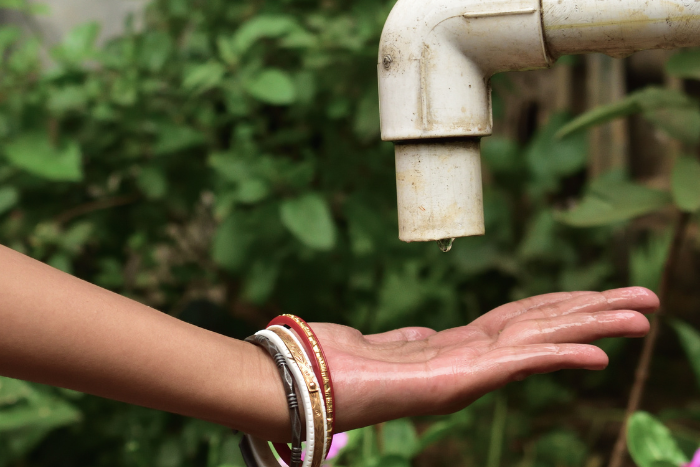As global temperatures rise, water supply will become more unpredictable, droughts will increase in frequency and severity, and disease outbreaks after floods will become more likely, says the report
Population and economic growth, coupled with environmental degradation and climate change, have greatly intensified the global water crisis, said the new report by the World Bank.
According to the report, there were 2.2 billion people without access to safely managed drinking water services and 3.5 billion without access to securely managed sanitation in 2022. Moreover, inequalities continue to exist between regions, with rural communities suffering the most from poor access. Access to clean drinking water has declined, especially in low-income nations, where an additional 197 million people have lost access since 2000.
The report aimed to identify the water challenges and risks faced by the most marginalised populations and to inform policies that enhance water accessibility and climate resilience while alleviating poverty and boosting shared prosperity.
Water cycle and climate change
The report said that climate change manifests itself mainly through its impact on the water cycle. As global temperatures rise, water supply will become more unpredictable, droughts will increase in frequency and severity, and disease outbreaks after floods will become more likely. These water shocks can lead to crop damage, lower food supplies and income, higher food prices, and increased risk of waterborne disease.
Water shocks also threaten peace and stability, the report added. Rainfall anomalies are shown to be associated with increased incidences of conflict and social unrest, particularly in countries where rainfed agriculture is the dominant source of income. Developing countries and poor households are most exposed to climate shocks. During the period between 2000 and 2021, developing countries have been disproportionately affected by droughts, experiencing more widespread and severe episodes compared to developed countries. Developing countries are also more susceptible to flood-related risks and have endured longer-lasting floods during the same period. Within countries, in urban areas, the poor are disproportionately at risk from flooding.
Additionally, low-cost housing in flood-risk areas is more affordable for the poor than other options. Despite the perceived riskiness of flood-prone areas, socioeconomic factors often force the poor to settle in these areas. Climate shocks can have significant and long-lasting impacts on vulnerable households. The poor are systematically underinsured. Uninsured or partially insured climate risks can increase risk aversion and can shift income-maximising investment to risk-reducing investment or discourage it altogether.
For example, the report said, farmers are likely to stop using fertiliser, leading to lower income growth in the long term. Droughts and floods can also lead to disinvestment in human capital development, with school dropout rates increasing as a coping strategy to deal with financial hardships caused by water shocks.
Extreme floods can also affect school attendance by disrupting physical access to school facilities. The current report estimates that extreme-flood-induced school absenteeism during 2000–22 will result in a lifetime earnings loss of $565 billion for affected school children at the global level, with those in low-income countries being particularly affected. The interconnected and cumulative impacts of climate shocks on income and human capital could cause an additional 68 million to 135 million people to fall into poverty by 2030.
The way forward
When water resources, infrastructure, and services are not adequately managed, developed, and delivered, water-related challenges—issues with too much, too little, or too polluted water—can exacerbate inequalities and fragility. Throughout the value chain of water supply, from source to distribution, three types of interventions can significantly improve water security and, concurrently, reduce poverty and increase shared prosperity.
The report recommended interventions which aim to achieve resilience to extreme hydro-climatic risks, water resources development and coordinated allocation to different water uses, and equitable and inclusive delivery of water services.
The report said that resilience to extreme hydro-climatic risks for the poorest can be enhanced by setting up robust and inclusive early-warning systems. Developing insurance programs for weather risks and scaling up social protection schemes to assist vulnerable communities impacted by floods, droughts, or both could significantly help.
Scaling up nature-based solutions through innovative financing schemes and evidence-based approaches, enabling coordination of and cooperation for water allocation through information sharing and financial incentives and adopting water accounting to inform water allocation decisions could improve water resources development, management, and allocation.
And finally, establishing participatory water governance to ensure transparency and accountability, creating an enabling regulatory and policy environment to promote innovations and improving coordination of institutions responsible for water, health, education, and urban planning could lead to equitable and inclusive service delivery.
About The Author
You may also like
22 July goes down as the world’s hottest day on record
Tropical forest biodiversity at high risk from climate change due to temperature change under canopies: Study
India’s June rainfall 11% below normal, fifth-lowest since 2020
With record breaking rain and heat, Uttarakhand reels under climate change impacts
Earth surpasses 1.5°C warming threshold for 12 months in a row


